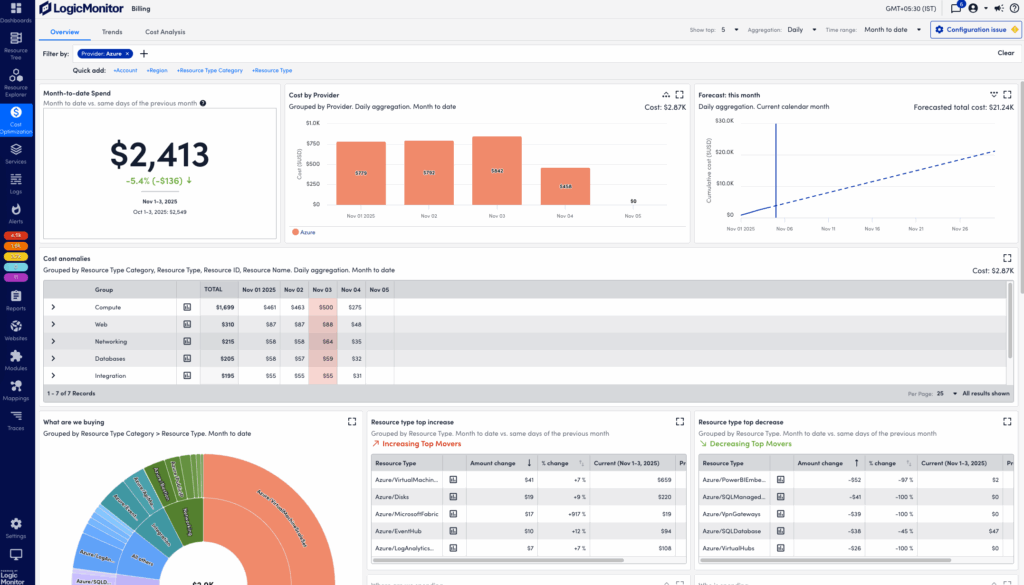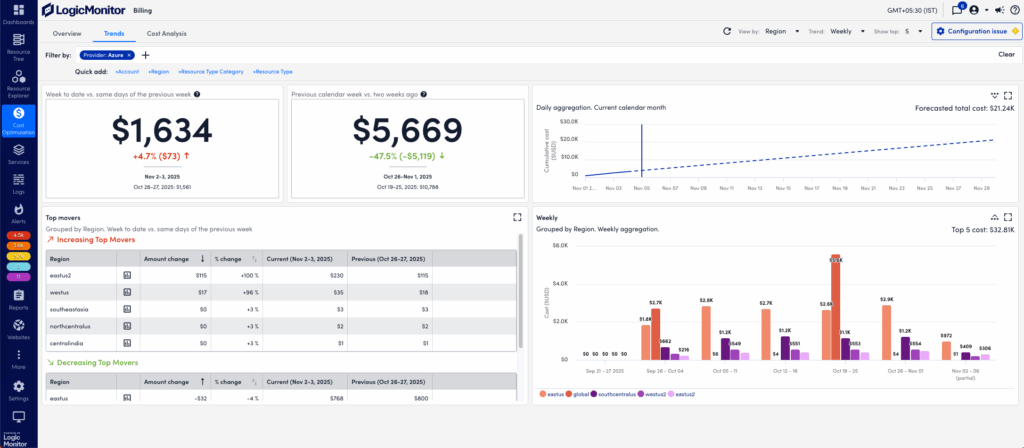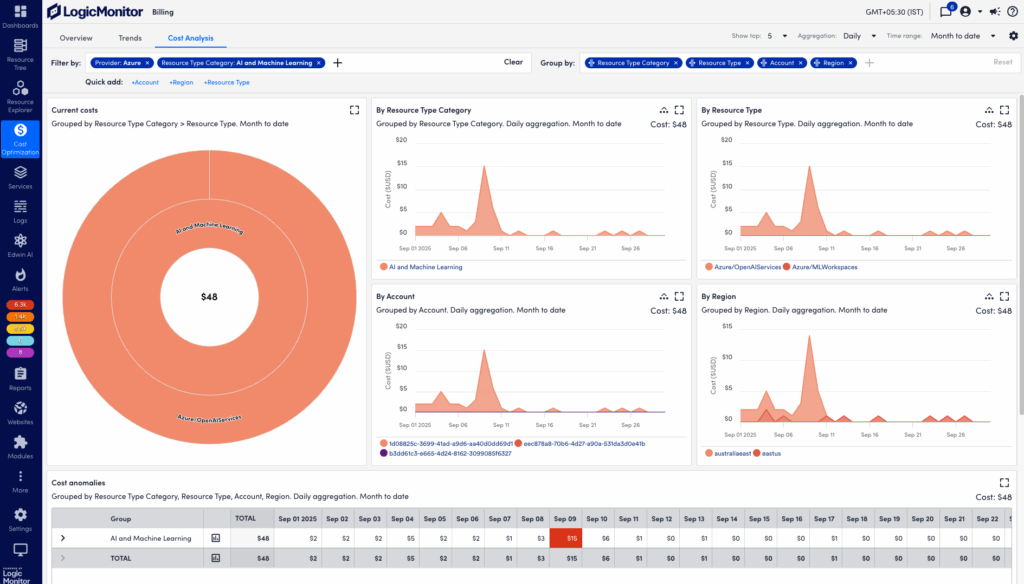Cost Optimization – Billing
Last updated - 10 November, 2025
The Cost Optimization Billing dashboard provides a detailed view of costs generated by resources in your cloud environments. Use Billing to get an overview of cloud spending, break down costs by specific criteria like location or resource type, and observe trends in resource costs.
To receive billing data from cloud providers, you must configure each provider to export cost information to LogicMonitor. For more information on configuring billing, see Cost Optimization Billing Configuration.
Billing provides the following tabs to organize how you observe your cloud spending:
- Overview—Displays a wide range of billing data for your environment. Visualizations in this tab provide an overview of the billing details such as month-to-date spending, monthly and yearly forecasts, saving opportunities, and more. These features enable you to view overall cloud costs, and focus on key aspects of those costs to optimize spending in your cloud environments.
- Trends—Tracks spending history to provide insight about historical increases or decreases in costs for your cloud environments. Visualizations in this tab display changes in cost, forecasts, and top movers for increases and decreases in cost. There are also visualizations that display cost trends for compute, storage, database, and networking resources.
- Cost Analysis—Enables detailed observation of spending across your cloud environments. Visualizations in this tab display current total cost breakdowns, costs by category, and cost anomalies. Each visualization provides drill down options to focus on more specific dimensions within the filters you set. You can also navigate directly to Resource Explorer to review resources that match selected dimensions.
Use the filter and group features on each tab to filter and group billing data by specific properties. The Quick add feature to easily add filter properties for provider, account, region, resource type category, and resource type. Visualizations within each tab update automatically to reflect the selected filter and group settings.
You can also create Billing and Forecast widgets in LogicMonitor Dashboards to further customize your Billing visualizations. For more information, see Billing Widget and Billing Forecast Widget.
Requirements for Using Cost Optimization Billing
To use Cost Optimization Billing, you need the following:
- A user with the “Cost Optimization” permission set. For more info, see Cost Optimization Role Permissions.
- Billing configurations for each cloud environment you monitor with Cost Optimization. For more information, see Cost Optimization Billing Configuration.
Filtering Billing Overview Data
- In LogicMonitor, navigate to Cost Optimization > Billing.
- Select the Overview tab.
- In the Filter by field, select
 Add to choose a filter property, and enter any details to refine the selected filter.
Add to choose a filter property, and enter any details to refine the selected filter.
You can also select a property in the Quick add list to add filter properties for provider, account, region, resource type category, and resource type.
Visualizations update automatically to reflect the selected filters. - (Optional)Select Clear to remove any filter properties and view the default overview for all widgets.
- In the Show top dropdown menu, select a value to adjust how many resource properties to include in billing data results.
For example, selecting “10″ adjusts billing data for the 10 resources with the highest associated cost. - In the Aggregation dropdown menu, select an aggregation rate and time range to adjust the aggregation breakdown of billing data.
For example, selecting “Daily” and “Year to Date” displays costs generated each day from the beginning of the current year.
Overview visualizations automatically update to reflect the selected filter configurations.

Filtering Cost Optimization Trends Data
- In LogicMonitor, navigate to Cost Optimization > Billing.
- Select the Trends tab.
- In the Filter by field, select
 Add to choose a filter property, and enter any details to refine the selected filter.
Add to choose a filter property, and enter any details to refine the selected filter.
You can also select a property in the Quick add list to add filter properties for provider, account, region, resource type category, and resource type.
Visualizations update automatically to reflect the selected filters. - (Optional)Select Clear to remove any filter properties and view the default overview for all widgets.
- In the View by dropdown menu, select a category by which to further filter trend results.
- In the Trend dropdown menu, select “Weekly” or “Monthly” to customize the time range of billing trends.
- In the Show top dropdown, select a value up to “25” to adjust how many resource properties to include in billing data results.
For example, selecting “Region”, “Weekly”, and “5” displays the largest change in billing per week for the top five regions in your cloud environments.
Trends visualizations automatically update to reflect the selected filter configurations.

Filtering Cost Optimization Cost Analysis Data
- In LogicMonitor, navigate to Cost Optimization > Billing.
- Select the Cost Analysis tab.
- In the Filter by field, select
 Add to choose a filter property, and enter any details to refine the selected filter.
Add to choose a filter property, and enter any details to refine the selected filter.
You can also select a property in the Quick add list to add filter properties for provider, account, region, resource type category, and resource type.
Visualizations update automatically to reflect the selected filters. - (Optional)Select Clear to remove any filter properties and view the default overview for all widgets.
- In the Show top dropdown, select a value to adjust how many resource properties to include in billing data results.
For example, selecting Show top “10″ adjusts billing data for the 10 resources with the highest associated cost. - In the Aggregation dropdown menu, select an aggregation rate and time range to adjust the aggregation breakdown of billing data.
For example, selecting “Daily” and “Year to Date” displays costs generated each day from the beginning of the current year.
Cost Analysis visualizations automatically update to reflect the selected filter configurations.


